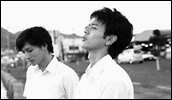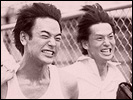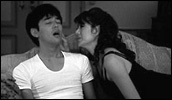Sixty Nine
- Year
- 2004
- Original title
- 69 Sixty Nine
- Director
- Cast
- Running time
- 114 minutes
- Published
- 25 July 2005



by Tom Mes
The cloud of mystique and nostalgia that surrounds the late 1960s is so thick that you could cut it with a machete. Anti-war protests, clashes with riot police, strikes, flirtations with communism, bra-burning, free love, rock 'n' roll, and LSD; the days of Jimi, Jim, and Janis are still elevated to the level of myth everywhere from Austin Powers to the bistros of the Parisian soixante-huitards.
But as Iggy Pop testified in the song of the same name, to those who didn't happen to be living in Paris or on a university campus, 1969 was just "another year with nothing to do." Lee Sang-Il's film Sixty Nine, scripted by golden boy Kankuro Kudo after the novel by Ryu Murakami, focuses on those kids to whom the turmoil seems distant and exotic. To its smart alec protagonist Ken (Tsumabuki), stuck in a rural backwater near Nagasaki while the rest of the world is on fire, the zeitgeist is summed up in a single image: naked women at Woodstock. If rock festivals make women spontaneously undress, Ken figures he and his friends must organise their own festival if he is ever to get to first, let alone second, base with Matsui (Ota), the school beauty.
What ensues is an infectious, footloose procession of picaresque tomfoolery, through which Sixty Nine dispenses entirely with the myths of the sixties. Ken and his buddy Adama (Ando) hang out with student protesters, watch Godard movies, and barricade the school, but, as their misspelled slogans on the wall indicate, the last thing on their minds is politics. Other than a universal and timeless wistfulness for adolescent monkey business, this film remains nostalgia-free. Its screenwriter and director, both born in the mid-70s, refuse to pay the kind of lip service that filmmakers of their parents' generation might resort to. Bernardo Bertollucci tried to create a similar pocket of insulation amid the May 68 turmoil in The Dreamers, but lacked the guts that Lee shows in following his intention through. Not for one moment does Sixty Nine go for the pretence of authenticity: its style is thoroughly of today and its music very obviously not of the period. Lee tries to neither emulate a sense of longing nor go for retro kitsch by utilising pseudo-psychedelic visuals or a Scorsese-esque barrage of period pop tunes.
To all intents and purposes, Sixty Nine is a contemporary film. By focusing on carefree kids to whom revolution is merely a pose, Lee is saying a thing or two about today's Japanese youth as well. Ken and Adama may be destined never to travel far beyond the grassy hills of rural Sasebo, but their isolation isn't all that different from the self-imposed exile of the Tokyo youth of today, who seem to spend their entire lives on the 15 square kilometres between Ikebukuro and Shibuya and have little inkling of what is going in the rest of the world, beyond how this lends itself to hollow posing. If the streets around Harajuku station are home to the world's most outrageous 24-hour fashion show, it's mainly because the models lack the sense of perspective to realise that they look like idiots. At least Ken and Adama didn't have much of a choice.